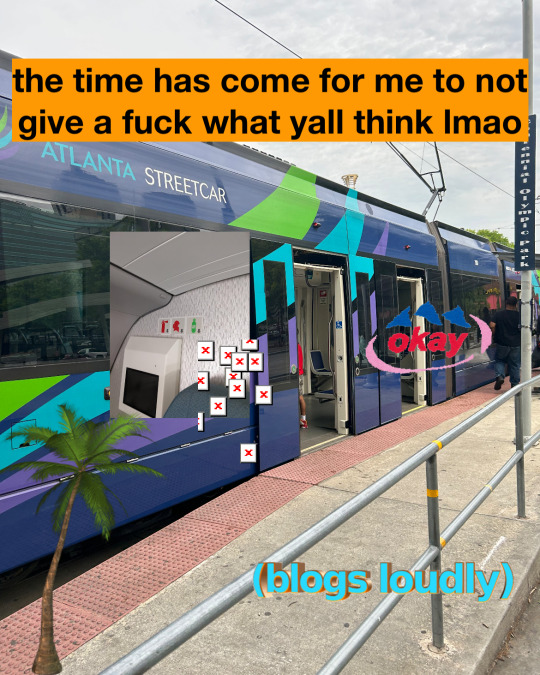#atlanta streetcar
Explore tagged Tumblr posts
Text
Mothball the Atlanta Streetcar?
Darin Givens | Dec 20, 2024
In a new op-ed in the Atlanta Journal Constitution [paywalled], former Council member and early Beltline champion Cathy Woolard makes a great case for Beltline rail, but she opposes extending the current streetcar to it.
In fact she calls for mothballing the existing streetcar. I'm surprised by my own reaction to this.
Here's a passage from the op-ed:
Ridership on the Atlanta Streetcar is virtually nonexistent and costs us a lot of money to operate this train to nowhere. No real leadership has stepped forward to say what needs to be said: the Atlanta Streetcar is too expensive, was poorly conceived and should never have happened. Many operate under the belief that we can’t receive funding for transit on the Atlanta Beltline unless it is part of the extension of the Atlanta Streetcar. Well folks, it’s time to put on our big girl pants and do something bold. Mothball the streetcar. Give up. Stop. Save it for later if it makes sense to restart. Do not extend this folly to the Beltline. Stop studying the studies. The density needed to provide riders exists in the Northeast and Southeast corridors and is rapidly being built in the Southwest and Northwest corridors. The alignment is there, and the need for fixed rail is studied and established and doesn’t need to be revisited until our “Atlanta Way” leaders get the results they want, which is no transit on the Beltline. Solicit bids to design and build transit on the Atlanta Beltline now. Other cities have figured out how to build transit lines quickly and with reasonable budgets.
Five years ago I would have immediately disagreed with ditching the streetcar. I like it, I ride it, and I believed back then that we could correct the issues with it.
But this month marks 10 years since the streetcar began service and it's becoming clear to me that Atlanta leaders and property owners have little will for converting 100% of the dead spaces near the streetcar tracks into rail-supportive density.

Atlanta also shows no political will for providing the streetcar with the lane priority it needs during big Downtown events.
It's a noble cause to call the city out on these failures, but as much as I hate to say so, it increasingly feels like a lost cause to me.

I'm not saying that I completely agree with Woolard that we should mothball the streetcar. That would be a huge move, and it's possibly even more pessimistic than I'm willing to be. But I'm surprised to find that I can now at least see a reasonable argument for it.
It's been over 15 years since ATL got the TIGER federal grant for the streetcar.
We've had 15 years for addressing the urbanism of the route. Some progress has been made, to be sure, but not nearly enough.
I don't believe simply connecting the streetcar to the Beltline is the answer. If it's just a matter of connectivity, it's a 10 minute bus ride from Ponce City Market (and the Beltline beside it) to North Avenue MARTA Station.
In summary, I believe that rail on the Beltline itself is *much* more important than a streetcar extension to it.
And if Atlanta leaders and property owners can't improve the urbanism of the streetcar route in a total, holistic way, soon, then a serious conversation about the potential for shelving it makes sense.
What say you?
3 notes
·
View notes
Text

I still get happy every time I see the streetcar. I like the sound of it -- the quiet hum of the wheels, the ding of the electric bell. I know all the reasons there are for criticizing it. But I prefer the reasons for improving it and building great things around it.
37 notes
·
View notes
Text
Cali Lili : “JD Salinger Is My Tap Water (but I still love a Hollywood ending in four part harmony)“ ©️ The Ironies & Ecstasies of Escalating Risk in Film, Art, Life ; Or How I Spent International Women’s Day & Memorial Day 2024 while John Roberts’ So Called Supreme Court Revoked Women’s Rights “ ©️ Cali Lili all rights reserved
©️ Cali Lili reflections 🏊♀️ from the cali lili indies ™️ 🏝️ currents leaps n’ landingZ ™️ 🌊🐬🌊 JD Salinger Is My Tap Water (but I still love a Hollywood ending) ; From Ramrod To Eve N’ God This Female Is Not Yet Rated ; The Ironies & Ecstasies of Escalating Risk in Film, Art, Life or How I Spent International Women’s Day 2024 while John Robert’s So Called Supreme Court Revoked Women’s…

View On WordPress
#A streetcar named desire#actress#art house film#Atlanta#auteur#Avant garde#©Cali Lili©™#Cali Lili Hauser#Cali Lili Indies ™#cine#cinema#feminista#feministe#filme#Global Pride#independent cinema#independent film#indie film#lgbtqia#Marlon Brando#memorial day#My body my choice#new actress#new director#pride#pride month#Save democracy#scotus#singer songwriter#supreme court
0 notes
Text
Here are the 25 largest US cities

Of these cities:
10 have a heavy rail metro system (NYC, LA, Atlanta, DC, Philly, Miami, Boston, San Francisco, Baltimore, Chicago)
12 have streetcars (NYC, Boston, Seattle, Philly, Portland, Tampa, Portland, St.Louis, Detroit, Dallas, Atlanta, DC)
14 have a light rail system (NYC, Dallas, Houston, Portland, Pheonix, Seattle, Minneapolis, San Diego, Denver, Baltimore, Charlotte, St.Louis, San Francisco, Boston)
16 have Commuter Rail (NYC, LA, Chicago, DC, Philly, Boston, Seattle, San Francisco, Minneapolis, San Diego, Denver, Baltimore, Orlando, Portland, Riverside, Dallas)
And San Antonio has no fixed guideway transit
302 notes
·
View notes
Photo
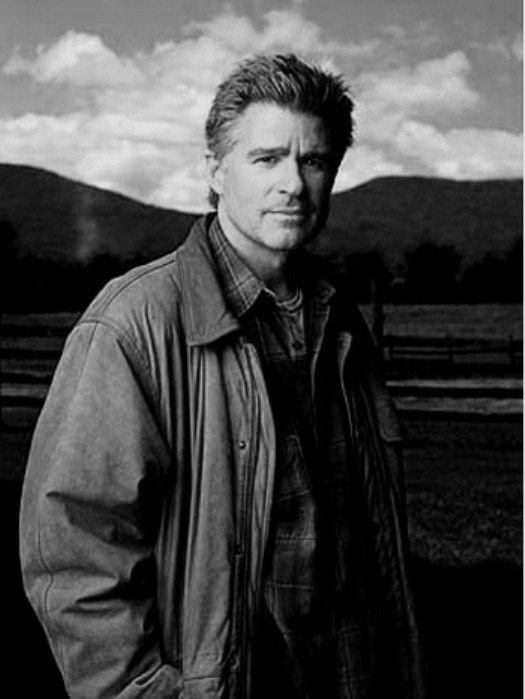
Richard Treat Williams (December 1, 1951 – June 12, 2023) Film, stage and television actor, author, and aviator.
Predominately a film star he starred as Dr. Andy Brown on The WB's Everwood (2002–2006), for which he was twice nominated for the Screen Actors Guild Award for Outstanding Performance in a Drama Series. He received Golden Globe and Emmy nominations for his work in the television films A Streetcar Named Desire (1984) and The Late Shift (1996), respectively, and had recurring roles on Brothers & Sisters (2006), White Collar (2012–2013), and Chicago Fire (2013–2018).
Williams made several guest appearances on the ABC drama Brothers & Sisters as David Morton, a friend and potential suitor of Sally Field's character. He starred in the short-lived series Heartland on TNT as Nathaniel Grant, which was canceled due to low ratings. He also starred in a Lifetime movie, Staircase Murders, which aired April 15, 2007.
Williams starred in a Hallmark Hall of Fame movie, Beyond the Blackboard, with his former Everwood co-star, Emily VanCamp. It was first broadcast on CBS on April 24, 2011.
He appeared in the CBS television pilot Peachtree Lines as Mayor Lincoln Rylan. The serial is an examination of political, social, and cultural issues in Atlanta.
He played the role of Mick O'Brien in a Hallmark Channel television series called Chesapeake Shores which aired from 2016 to 2022. (Wikipedia)
IMDb listing
#Treat Williams#TV#Obit#Obituary#o2023#Everwood#Heartland#Chesapeake Shores#Brothers and Sisters#White Collar#Chicago Fire
61 notes
·
View notes
Text
Population growth & rail stations need better alignment in Atlanta
Darin Givens | April 10, 2024
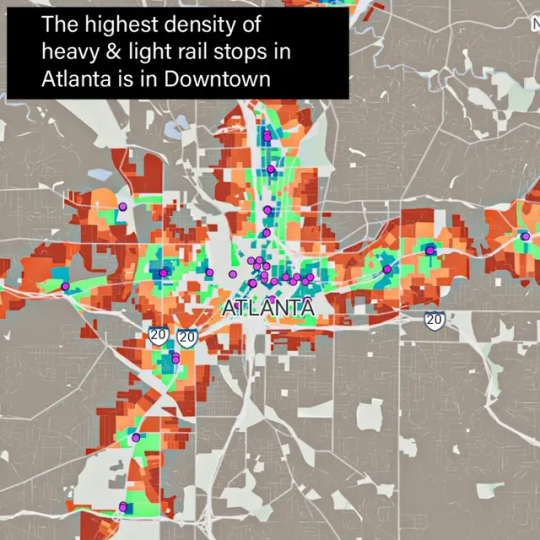
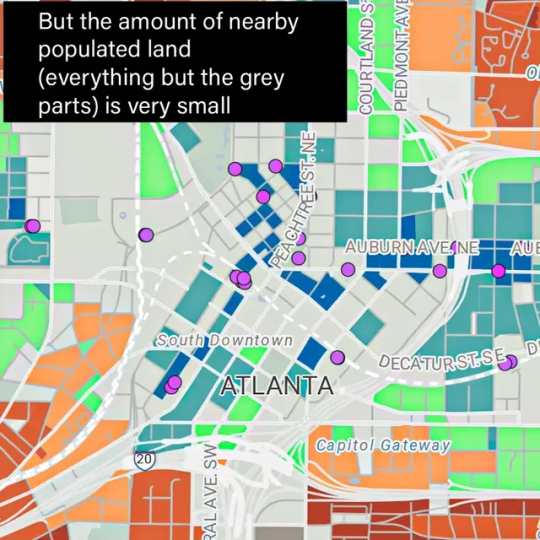
Check out the maps above. They clearly show that the highest density of light rail & heavy rail stops in Atlanta is in Downtown, but that only a small amount of land near those stops is populated by any level of residential development.
This is data that we likely already knew, but seeing it mapped out so clearly is impressive. And it should make us think about whether we're doing all we can to make the best use of our biggest investments in rail.
As we've found out the hard way over the last 30 years, building new rail lines or infill stations is incredibly expensive and doesn't happen quickly (the last rail line MARTA built was the one to North Point Station which opened in 2000).
We shouldn't stop planning for expansion of rail, such as the line promised for the Beltline, but making the best use of land near our existing rail service is at least as crucial as expansion.
Our track record is grim. Many parking lots and empty buildings sit within a couple of blocks of the Atlanta Streetcar tracks. And this, below, is the blighted area surrounding Garnett MARTA Station in Downtown.
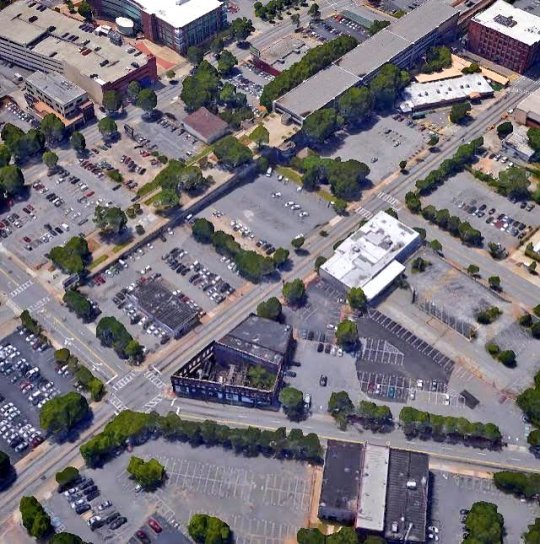
Matching development -- with a big dose of residential density -- with our rail stations is common sense, Urbanism 101 stuff. It shouldn't be as hard as we've made it out to be in Atlanta. We can and must do better.
These maps at the top of this post were made with an impressive mapping tool, Close.city at www.close.city
The tool was built by Henry Spatial Analysis in Seattle. It lets you create walkability maps of various data points such as supermarkets, libraries, transit stops, and more.
14 notes
·
View notes
Text
Even car-friendly engineers never believed that Americans would abandon mass transit the way they did.
Frank Turner, the father of the interstate, took the bus to work most days and, as head of the Federal Highway Administration in the late 1960s, would open his meetings at bureau headquarters by asking: “How many of you came by bus today?” In 1953, fewer than half of the fifty-seven thousand people arriving in downtown Atlanta every day came by car, and in their parking assessment that year, city leaders believed that transit ridership would stabilize.
But the more parking lots cities built, the more people drove. Transit executives, whose long-held (and widely despised) monopoly was coming to an end, were some of the first to sound the alarm. The general manager of the Cleveland transit system, D. C. Hyde, argued in 1952 that parking was doing the opposite of what its builders believed: “Destroying buildings and using valuable land for more and more parking lots and garages hastens decentralization. . . . It is just as sensible to stop doing things that bring more automobiles into already congested areas as it is to stop buying drinks for a person who is already drunk.”
Like transit officials in Detroit and elsewhere, Hyde reminded his audience that streetcars and buses were by far the most efficient use of precious street space—and were being rendered useless by automobile traffic.
#book : paved paradise#public transportation#cars#frank turner#usa#1960s#20th century#1950s#urbanism
3 notes
·
View notes
Text
I have decided that my "fuck Dwight Eisenhower" tangent bares mention sooner, given most people don't hate him. Eisenhower was the sun of a KATY railroad station agent, before his father got laid off, which destroyed his family. After coming back from Europe, Eisenhower spearheaded the interstate highways which not only targeted Railroads with surgical precision, killing affordable interstate travel by train, but also...
-Demolished black neighborhoods
-Enabled white flight
-enabled industrial flight
-accelerated the affects of over 100 years of segregation and forced poverty
-destroyed our cities.
Dwight Eisenhower is personally responsible for the US being as horrible as it is now, for killing a streetcar network so robust you could take a streetcar from Portland Maine to Atlanta Georgia without long distance walking. For destroying small town transit. For making sure if you don't own a car, your life will be extra hard. For making racism worse. Fuck that guy.
26 notes
·
View notes
Text

"One of the problems in the United States is the refusal on the part of our young people to remember or to want to remember, or to recognize the experiences of the past as being relevant, germane, important to the present and to the future. They simply don't want anything that's painful. They want to live in a painless society where everything is pleasant, and everything is joyful."
The quiet but unrelenting legacy of historian John Hope Franklin might be said to have been foreshadowed years before his birth in Tulsa 1915; the son of Buck Colbert Franklin, himself a successful attorney and an eyewitness to the events of the Tulsa Race Massacre and its aftermath. John, himself named for John Hope, the first Black president of Clark Atlanta University, would later graduate from Fisk University in 1935, and then earn advanced degrees in history at Harvard --an M.A. in 1936 and then a Ph.D in 1941.
It would not be an easy path: as a child in Tulsa he rushed to help a blind white woman cross the street until she realized he was black and ordered him to take his "filthy hands off her." As a student at Fisk, he tells the story of having handed a $20 dollar bill to a streetcar employee and asking for change, inviting a racial slur. During World War II Franklin taught at both St. Augustine's College and at the North Carolina College for Negroes (today known as North Carolina Central University). Later in 1953 he worked with then-judge Thurgood Marshall and other NAACP lawyers on developing some of the legal arguments for what would become the Brown v. Board Of Education decision --during preparations, for a time he worked at the state archives in Raleigh, NC, where he was restricted to a small anteroom across from the "whites-only" research room. Franklin also participated with other fellow historians and academics in the march from Selma to Montgomery in 1965.
Over the course of his career Franklin published many books and historical studies, to include The free Negro in North Carolina, 1790-1860 (1943); and The militant South, 1800-1861 (1956), but Franklin's greatest accomplishment comes in the form of his 1947 publication of From Slavery to Freedom: a history of American Negroes, which first appeared during his tenure at Howard University (1947-1956). To this day the book remains a seminal text on African-American studies throughout the United States, now into its Ninth Edition and having sold upwards of 3.5 million copies. Fellow historian Henry Louis Gates Jr., cites the book as the definitive work on race relations in America, and named Franklin as his intellectual godfather and "the prince of black academics."
Following his time at Howard University, in 1956 Franklin became chairman of the Department of History at Brooklyn College --the first Black person to do so. In 1967 he then became a professor of American History at the University of Chicago; and in 1982 he returned to North Carolina, this time to teach at Duke University as Professor Of Legal History. In 1997 President Clinton appointed Franklin to lead One America, a national initiative on race.
"I hardly needed to seek a way to confront American racial injustice. My ambition was sufficient to guarantee that confrontation."
Franklin died at his beloved Duke (Duke Hospital) the morning March 25, 2009, having lived long enough to see a Black man elected to the U.S. Presidency. In 2010 the City of Tulsa renamed Reconciliation Park, established to commemorate the victims of the Tulsa Race Massacre of 1921, as John Hope Franklin Reconciliation Park.
2 notes
·
View notes
Text
Stop blaming Atlanta's streetcar for ridership failures and look instead at the urban design
There's a new, dimwitted rant against rail today from the libertarians at Reason. They argue that, because the current Atlanta streetcar is underused, any extension of it is bound to be useless.
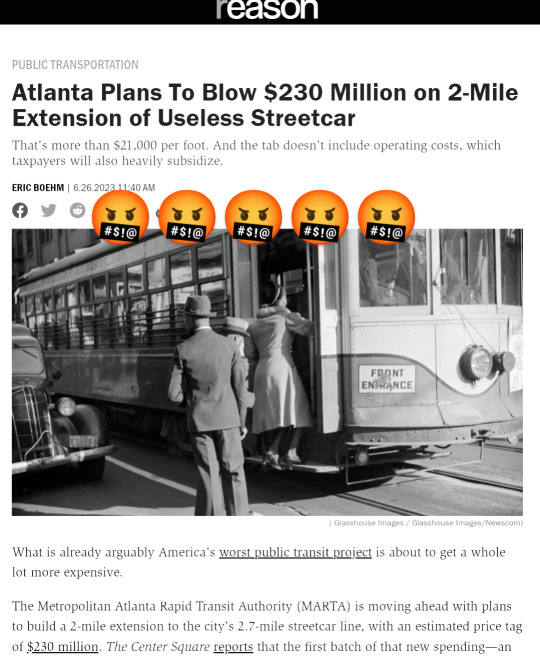
This argument is similar to the one where people see a useless bike lane that lasts only a few blocks and they say "look! No one's using it! We shouldn't build any more!"
Unfortunately, Atlanta's failure to improve the land-use around the current streetcar (or to give it priority over car traffic during big events) gives these anti-rail rants a level of credence that they don't deserve. It's a damn shame.
It's been 13 years since the federal government awarded Atlanta a $47 million grant for the current streetcar. The fact that much of the route is *still* abutted by empty buildings and parking facilities shows a gross misunderstanding of how land-use and transit should benefit each other.
And the fact that the streetcar gets regularly shut down during big events in Downtown, due to car traffic, is so ridiculous I often have trouble finding words.
In short, Atlanta isn't doing itself any favors when it comes to making a good case for street-rail expansion. These libertarian rants should be easier to rebut. We should have improved the urban design of Downtown to a level that helps street rail make great sense.
We still can, and should. Better late than never.
16 notes
·
View notes
Text
On September 22, 1906, after local newspapers reported sensational allegations that several white women had been assaulted by Black men, mobs of angry white men gathered in the streets of Atlanta, Georgia, to attack and kill Black men on sight. The mobs seized Black men on streetcars, trapping them inside and shooting or beating them to death. When the streetcars suspended service due to the violence, the rioting mobs ransacked Black businesses and chased, beat, and shot Black men wherever they could find them. The police and fire departments called upon to quell the unrest failed to restore order, and the militia was unable to stop the violence.
In a public statement during the rioting, Atlanta Mayor James Woodward placed blame on the Black men being killed rather than the white men doing the killing. “The only remedy is to remove the cause,” Woodward said. “As long as the Black brutes assault our white women, just so long will they be unceremoniously dealt with.”
Mayor Woodward’s statement empowered the mobs, and the massacre continued. For a total of four days, Black people were violently terrorized throughout Atlanta and its surroundings with little protection from authorities. In contrast, when Black citizens of the nearby Brownsville suburb attempted to arm themselves in defense, Georgia troops raided their homes, taking weapons and arresting those in possession of weapons. After four days of riots, at least 25 people were dead and countless more were injured.
#history#white history#us history#black history#am yisrael chai#jumblr#republicans#democrats#September 22 1906#September 22#white women#white woman#white men#white man#white mob#mob#Atlanta#Georgia#James Woodward
1 note
·
View note
Text




Tonight on CBS, it's "A Very Atlanta Thanksgiving: an ATL Urbanist holiday special!"
Featuring:
A walk through the Municipal Market, where giant bags of collard greens are being bought!
A visit to the Sweet Auburn Bread Company for delicious pastries!
A trip on the Atlanta Streetcar, using the Breeze Mobile app to purchase the $1 fare!
Brought to you by Sensational Subs, where the sandwiches are good and the Busch beer is cold.
Seriously, it's been an awesome lunch visit to Downtown.
20 notes
·
View notes
Text
[Video] We have a ready-made 150 year old vacant right of way aro…
We have a ready-made 150 year old vacant right of way around central Atlanta begging for rail based transit… And the mayor is considering “slow moving people movers” and “pods” instead of connecting the downtown circulating streetcar to it (which it was why it was built)
Please watch this video and feel my frustration and rage right now. 😡
https://youtu.be/ViXU2ULsPn8

0 notes
Text
Transit projects I think would be fun:
Cincinnati Streetcar Extension
Louisville Light Rail
Chicago Loop Line
Septa rebuild of those trolleys that were destroyed in that fire
Red Line, Baltimore
Atlanta beltline streetcar
Raleigh Durham Light Rail
Buffalo Subway extension to the University of Buffalo
251 notes
·
View notes
Text
Navigating the City: Atlanta's Comprehensive Transportation Services
Introduction
As one of the United States' major transportation hubs, Atlanta presents a dynamic and bustling atmosphere for travelers. Navigating the city's comprehensive Atlanta Transportation Services is a critical aspect of the overall travel experience. In this guide, we delve into the diverse options available for moving within Atlanta, providing insights into the city's transportation infrastructure and aiding visitors in making informed decisions for a seamless journey.

1. Urban Pulse: Understanding Atlanta's Transportation Landscape
An Overview of Atlanta's Transportation Infrastructure
Before embarking on the exploration of Atlanta's transportation services, it's crucial to grasp the city's overall landscape. Atlanta boasts a robust network of roads, highways, and public transit systems. The Hartsfield-Jackson Atlanta International Airport, one of the world's busiest airports, serves as a pivotal point for both domestic and international travel. Understanding this urban pulse is the first step in navigating the city effectively.
2. Metro on the Move: MARTA - Atlanta's Public Transit System
Efficiency in Commuting
The Metropolitan Atlanta Rapid Transit Authority (MARTA) stands as a cornerstone of public transportation in the city. Comprising buses and trains, MARTA provides an efficient means of commuting within Atlanta and its surrounding areas. The rail system connects key locations, including the airport, making it a convenient choice for both residents and visitors. MARTA's commitment to sustainability aligns with the city's efforts to provide eco-friendly transportation options.
3. Wheels on the Road: Private Vehicles and Highways
Freedom of Mobility
Atlanta's extensive highway system facilitates the ease of private vehicle travel. Renting a car or using ride-sharing services offers unparalleled freedom to explore the city at one's own pace. The network of highways, including the famous Perimeter and Downtown Connector, enables efficient travel across various neighborhoods and districts. However, travelers should be mindful of traffic patterns, especially during peak hours, to ensure a smooth journey.
4. Beyond the City Limits: Regional Transit Options
Connecting Atlanta to the Surrounding Areas
Atlanta's influence extends beyond the city limits, and several regional transit options cater to those looking to explore the surrounding areas. Commuter rail services and intercity buses provide connectivity to neighboring towns and cities, offering a broader exploration of the diverse landscapes and attractions in the metropolitan region.
5. Pedestrian-Friendly Neighborhoods: Walking and Biking Paths
Sustainable Exploration
Several neighborhoods in Atlanta embrace a pedestrian-friendly ethos, featuring well-maintained walking and biking paths. Exploring these areas on foot or by bicycle allows visitors to immerse themselves in the city's unique charm. From the historic streets of Downtown to the lush trails of Piedmont Park, walking and biking provide a sustainable and leisurely means of discovering Atlanta's hidden gems.
6. Cultural Connection: Streetcar and Trolley Services
Heritage in Motion
Atlanta's commitment to preserving its cultural heritage is reflected in the streetcar and trolley services that traverse historically significant areas. These charming modes of transportation offer not only a practical way to move within the city but also a nostalgic journey through Atlanta's history. Travelers can enjoy a unique blend of modern convenience and cultural enrichment.
Conclusion
Navigating Atlanta's comprehensive transportation services is an exploration in itself. From the efficiency of MARTA to the freedom of private vehicles, the regional transit options connecting to neighboring areas, the sustainability of walking and biking paths, and the cultural connection through streetcars and trolleys – each mode contributes to the diverse fabric of Atlanta's transportation landscape.
Understanding the nuances of these services empowers visitors to tailor their travel experience according to their preferences and priorities. Whether it's a brisk walk through historic neighborhoods, a ride on MARTA for efficient urban exploration, or a scenic drive on the city's highways, Atlanta offers a spectrum of transportation options. Embrace the diversity, navigate with confidence, and immerse yourself in the vibrant energy of a city in constant motion. Safe travels!
0 notes
